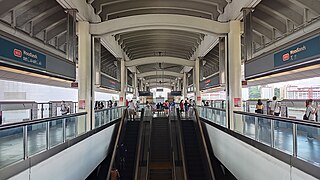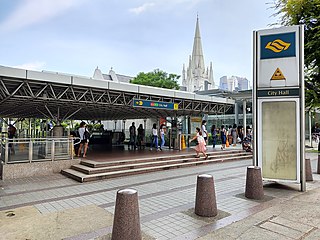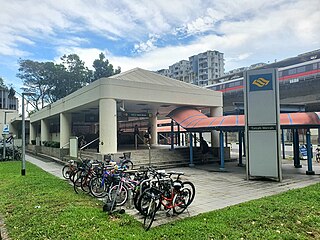
Transportation in Singapore is predominantly land-based, with a comprehensive network of roads making many parts of the city-state, including islands such as Sentosa and Jurong Island, accessible. The road network is complemented by a robust rail system consisting of the Mass Rapid Transit (MRT) and the Light Rail Transit (LRT), which cover the length and width of Singapore and serve a few neighbourhoods respectively. The main island of Singapore is also connected to other islands via ferryboat services. Furthermore, the city-state maintains strong international connections through two bridges linking it to Malaysia – the Causeway and the Second Link – and the Singapore Changi Airport, a major aviation hub in Asia.

The Mass Rapid Transit system, locally known by the initialism MRT, is a rapid transit system in Singapore and the island country's principal mode of railway transportation. The system commenced operations in November 1987 after two decades of planning with an initial 6 km (3.7 mi) stretch consisting of five stations. The network has since grown to span the length and breadth of the country's main island – with the exception of the forested core and the rural northwestern region – in accordance with Singapore's aim of developing a comprehensive rail network as the backbone of the country's public transportation system, averaging a daily ridership of 3.4 million in 2019.

The North East Line (NEL) is a high-capacity Mass Rapid Transit (MRT) line in Singapore. Operated by SBS Transit, the 20-kilometre (12 mi) line is the MRT's shortest. It runs from HarbourFront station in southern Singapore to Punggol station in the northeast, serving 16 stations via Chinatown, Little India, Serangoon and Hougang. Coloured purple on official maps, it is Singapore's third MRT line and the world's first fully-automated underground driverless heavy rail line.
SBS Transit Ltd is a multi-modal public transport operator in Singapore operating bus and rail services. With a majority of its shares owned by Singaporean multinational transport conglomerate ComfortDelGro Corporation at 75%, it was formerly known as Singapore Bus Services before rebranding to SBS Transit on 1 November 2001.

The Land Transport Authority (LTA) is a statutory board under the Ministry of Transport of the Government of Singapore.

The North–South Line (NSL) is a high-capacity Mass Rapid Transit (MRT) line in Singapore, operated by SMRT Corporation. Coloured red on the Singapore rail map, the line is 45 kilometres (28 mi) long and serves 27 stations, 11 of which, between the Bishan and Marina South Pier stations, are underground. It runs from Jurong East station, located in Western Singapore, to Marina South Pier station in the Central Area, via Woodlands station in northern Singapore. The line operates for almost 20 hours a day, with headways of up to 1 to 2 minutes during peak hours and 5 to 8 minutes during off-peak hours. All the trains on the North–South Line run with a six-car formation.

The Bukit Panjang LRT is a 8-kilometre (5.0 mi) automated guideway transit line in Bukit Panjang, Singapore. The BPLRT is currently the only LRT line operated by SMRT Trains. As the name suggests, it serves 13 stations in the neighbourhood of Bukit Panjang and parts of Choa Chu Kang in the north-west of the country. The line was the first LRT line constructed in Singapore, having opened on 6 November 1999 by Deputy Prime Minister Tony Tan.

City Hall MRT station is an underground Singapore Mass Rapid Transit (MRT) interchange station on the North–South line (NSL) and East–West line (EWL). Situated in the Downtown Core district, it is underneath Stamford Road near the road junctions with North Bridge Road and St Andrew's Road. The station is near landmarks such as the former City Hall, Raffles City, the Padang, St Andrew's Cathedral and the Cenotaph.

Changi Airport MRT station is an underground Mass Rapid Transit (MRT) station serving Changi Airport and its supplementary structure Jewel in Changi, Singapore. The station is the terminus of the Changi Airport branch of the East West line (EWL); it is operated by SMRT Trains and is built in an east–west direction. The ends of the station directly connect to Terminals 2 and 3 of Changi Airport.

Marina Bay MRT station is an underground Mass Rapid Transit (MRT) interchange station on the North South (NSL), Circle (CCL) and Thomson–East Coast (TEL) lines in Singapore. Located in the Downtown Core district near Marina Bay, the station serves the Marina One Residences, Marina Bay Suites and the Marina Bay Financial Centre.

Public buses form a significant part of public transport in Singapore, with over 3.6 million rides taken per day on average as of December 2021. There are 352 scheduled bus services, operated by SBS Transit, SMRT Buses, Tower Transit Singapore and Go-Ahead Singapore. The newest bus operator, Go-Ahead Singapore started operation on 4 September 2016. There are also around 5,800 buses currently in operation as of 2020.

The Light Rail Transit (LRT) is a series of localised automated guideway transit systems acting as feeder services to the heavy rail Mass Rapid Transit, which together forms the core of Singapore's rail transport services. The first LRT line was opened in 1999 and the system has since expanded to three lines, each serving a new town, namely Bukit Panjang LRT line, Sengkang LRT line and Punggol LRT line. Trains on these lines have at least one station interchange link to the MRT.

Woodlands Bus Interchange is a bus interchange in Singapore. Located in Woodlands, the interchange is linked to Woodlands MRT station and adjacent to Causeway Point shopping mall. It is the largest and among the busiest bus interchange in Singapore. The interchange is also known as Woodlands Integrated Transport Hub.

SMRT Buses is the second largest bus operator in Singapore. A subsidiary of SMRT Corporation, it traded as Trans Island Bus Services until 10 May 2004.

Tanah Merah MRT station is an elevated Mass Rapid Transit (MRT) station on the East West line (EWL). Located in Bedok, Singapore, the station is along New Upper Changi Road and serves various residential developments, including Casa Merah. It is the terminus of the EWL branch to Changi Airport station.

The history of the Mass Rapid Transit (MRT) system of Singapore commenced with its planning in the 1960s, which finally led to its opening in 1987 with the launch of a 6 km section of the North South Line (NSL) from Yio Chu Kang to Toa Payoh. Since its inception, the rapid transit system has played a crucial role in the public transportation network and the wider development of the country as a whole, providing a fast and efficient means of transportation for millions of Singaporeans daily.

Kranji MRT station is an elevated Mass Rapid Transit (MRT) station on the North South line (NSL). Situated in Sungei Kadut, Singapore along Woodlands Road, it serves the Singapore Turf Club and the Woodlands Wafer Fabrication Park. The station is operated by SMRT Trains.

Rail transport in Singapore mainly consists of a passenger urban rail transit system spanning the entire city-state: a rapid transit system collectively known as the Mass Rapid Transit (MRT) system operated by the two biggest public transport operators SMRT Trains and SBS Transit, as well as several Light Rail Transit (LRT) rubber-tyred automated guideway transit lines also operated by both companies. In addition, local specialised light rail lines are in operation in places such as the Singapore Changi Airport and Sentosa.

SMRT Trains Limited is a rail operator in Singapore and a wholly owned subsidiary of SMRT Corporation. After the privatisation of the MRT operations in 1995, it was originally named Singapore MRT Limited. On 31 December 2001, it was renamed SMRT Trains Limited, so as not to confuse with another MRT line - North East MRT Line that is under Singapore Bus Services and the bus operations merged from Trans-Island Bus Services. At the same time, Singapore Bus Services was renamed SBS Transit to be multi-modal. SMRT Trains currently manages most of the MRT services in Singapore except the North East Line and Downtown Line.




















